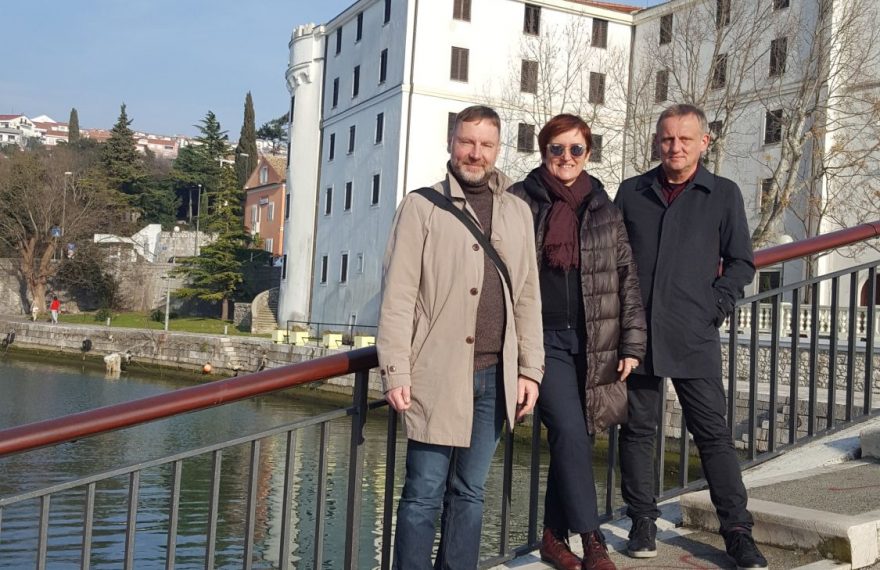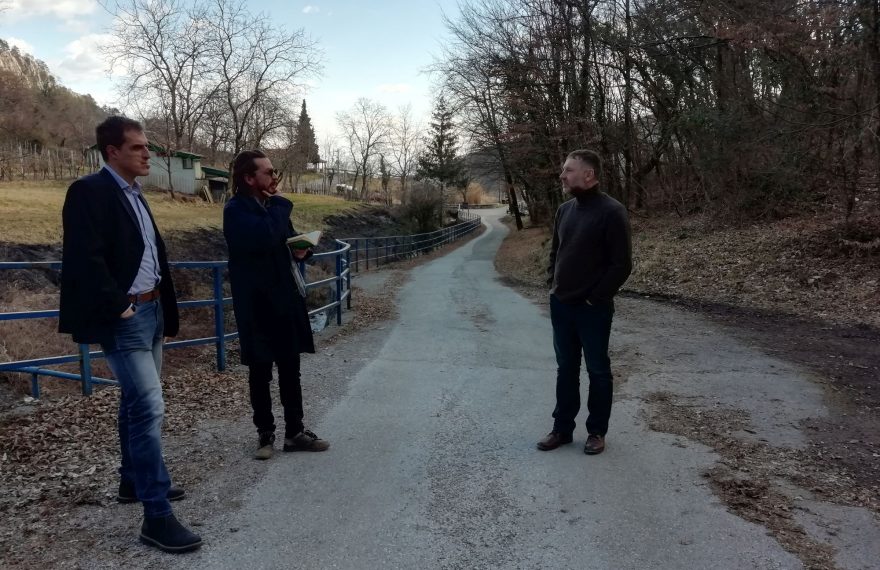A highlight of April and May of this year were the study visits of a few Lungomare artists with the aim of becoming thoroughly familiarized with the locations selected for the research that will culminate in permanent art installations.
The Lungomare Art flagship will display permanent artworks at 10 locations in the Kvarner region. All of the works deal with certain specifics of the location in which they are installed, with the guiding principle being to concentrate on the aspect that is important to the local population, that which they themselves consider important, and that links the past to the present to some extent. The curator of the Lungomare Art flagship is the renowned European curator, the Czech Michal Koleček, who selected the artists.
The Japanese artist Harumi Yukutake, whose future art installation will be displayed in Kapić park near the ferry port, stayed in Lopar on Rab Island during her second study visit.
– The park where my installation will be displayed is currently a vacant open space, although the location itself is quite beautiful. The colours of the sea and sky coalesce, with a striking white stone hill on the other side of the shore. Being a glass artist, I am quite impressed with the legend of how the sand from this area was used to make Venetian glass, said Yukutake, a world-renowned Japanese artist who uses glass as a primary medium in her art. Her works have been included in the holdings of various world museums and this is her first time working in Croatia, courtesy of Rijeka 2020 – European Capital of Culture. – I have never travelled to countries such as Croatia, where I feel very safe. And best of all, this is a gorgeous country with a rich history and stunning nature. I feel right at home!
The picturesque town of Volosko on the western side of Kvarner Bay was visited for the first time by the acclaimed Czech artist Jiří Kovanda, who is working on his art installation in the main square on Andrije Štangera Street in collaboration with the young local artist Nika Laginja. – It is a tranquil place that exudes history. My work will also deal with changes that occur with time. The young artist Nika Laginja and I are currently planning the end result of our artwork and we are intensely selecting the materials that we will use for our works, Kovanda pointed out during his visit to Volosko, which is not his first time in Croatia. – I’ve had two solo exhibitions in your country. One in Dubrovnik and the other right here in Rijeka, as a result of collaborating with Slaven Tolja, the art director of RIJEKA 2020. Croatia has always left a good impression on me!
Nika Laginja, a young artist from Opatija, was, in her own words, delighted when she was told that her installation would adorn Volosko. – To me, Volosko is one of those towns where I know every proverbial nook and cranny. I am pleased to be able to leave my mark here. This is the first project of such scope that I have undertaken, so it was not easy to relax. However, everything is running smoothly and going according to plan; we are more at ease and work hard, which for me is the key for great success. Laginja says that she is honoured to participate in the Rijeka 2020 – European Capital of Culture project. – I have been researching this installation for as many as 8 years and it has been a dream of mine to finish it, which has not been possible due to financial constraints. But now the sculpture is underway, once again proving that dreams do come true, concludes Laginja.
The Danish artist Sofie Thorsen spent a few days in Brseč, a medieval town perched on a cliff. Her prospective installation will be located at the entrance to the town, in a park near an old bocce court, and will address the closing of a school in Brseč in 2018 after 175 years of continuous operation. As with many other towns and villages, the public spaces change their purposes or even disappear entirely, while at the same time, despite all the difficulties troubling this community, Brseč boasts a group of involved townspeople of various ages that strives to develop the community in the best way possible. With the art installation inspired by stories of Brseč, the author will combine these two significant places – the currently abandoned primary school building and the aforementioned park located by the bocce court at the entrance to Brseč. At the same time, the park will be reimagined as a public space where one can spend time and socialize.
Thorsen has been captivated by the stunning nature and architecture in Brseč, a town that simultaneously tackles a number of contemporary issues dealing with tourism, urban and rural development, the modern economy and the significance of the landscape. – This is an interesting and complex basis for artistic work, says Thorsen, emphasising the importance of communicating with the locals in the entire process. – This is my first time working in Croatia, where the people are very open and eager to converse with me, as an artist coming from another part of the world, says Sofie Thorsen.
The Slovakian artist Ilona Németh was on her second study visit to Crikvenica with her husband, the co-author and architect Marián Ravasz. Today, Németh is an esteemed Professor at the Academy of Fine Arts and Design in Bratislava, and the installation in Crikvenica created by these two artists will be displayed in front of the Miramare hotel, by the entrance to the city beach. Nemeth is thoroughly familiar with the location in which their artwork will come to life. – Crikvenica has a very rich history, especially regarding hospitality, in every sense of the word; the hospitality shown when receiving people who require health care or rest, as well as hospitality towards migrants and refugees at various points in the 20th century, especially during the Homeland War in Croatia. Historically, the town has been associated with hospitality towards tourists, which directly influenced the appearance of the town, with a few hotels dating back to the period of Austro-Hungarian rule, such as Miramare and Terapija. Today, numerous apartments are being built in private houses. The town is naturally connected to the sea with a lovely walkway, Németh says. The spouses base their collaboration with the curator of the Lungomare Art flagship Michal Koleček on shared general life values, as well as a similar attitude towards the purpose and possibilities of contemporary art.
– We discuss ideas and topics of interest and collaborate in order to come up with the most inspirational artwork for Crikvenica that would pertain to the local populace and the history of the location. Németh and Ravasz have frequently travelled to Croatia as tourists but this is their first working visit. – We have worked on the European Capital of Culture project before, when we were involved in the programmes of Pecs, Hungary, in 2010 and Košice, Slovakia, in 2012. We are pleased to have been given the opportunity to participate in this bold and grand event, they conclude.
The Croatian artist Davor Sanvincenti will display his permanent installation, which deals with the connection between humans and nature, in Lovranska Draga. – During the first stage of my research, I became thoroughly familiar with the local customs and culture, which are extremely specific, starting with the protected chestnut gardens and such like, Sanvincenti points out. Each visit abounds in new findings and details pertaining to the social and environmental aspects of this area at the foot of Mount Učka. Throughout history, the people of Lovranska Draga, have mostly worked in agriculture, especially winemaking and cattle farming. In addition to grapevines, vegetables and fruit were grown in the fecund soil, with cherries and chestnuts being the most prominent today. Moreover, the main historical reason for settling in Lovranska Draga was the abundance and quality of water, which, along with its influence on the development of the location, sparked the author’s vision to complete an art pavilion that would double as a place for resting, socialising, learning and providing shelter, and which would be located next to the remnants of a mill by the hiking trail in Lovranska Draga that stretches from the seashore in Medveja to the summit of Mount Učka. Sanvincenti points out that the Rijeka 2020 – European Capital of Culture project might prove to be successful in the long run and not just for the time being, particularly when it comes to enhancing and strengthening the local communities, which is why he is extremely honoured to participate and, above all, thankful for the invitation.
This year, visits by the Czech artist Pavel Mrkus served to draft a proposal for a permanent installation that will be displayed on the gallery of the beautiful Rijeka Fish Market building at the central market in the city centre. Since the Rijeka fish market is extremely important for the identity of the city, my installation will attempt to appease the daily users of the location, as well as those working there and the visitors to the fish market, by honouring its heritage. It is an authentic space that tells its own story, which poses a great challenge for me since the installation I am displaying will be based on new technologies, Mrkus emphasised during his visit to the location. He will use light and sound in his work, which showcases the skills of fishermen and the power of nature. – This is my first time working in Croatia, Mrkus points out and continues by saying that his impressions have been positive, in no small part due to the well-organised team of the Lungomare Art flagship. – I am happy to be a part of the Rijeka 2020 – European Capital of Culture project, he concludes.
Although the entire programme of the Rijeka 2020 – European Capital of Culture project and the Lungomare Art flagship will be kept under wraps until its announcement in September 2019, as is the practice of other European Capitals of Culture, we are already privy to the names of the renowned artists visiting Kvarner, as well as other artists practicing this style of art, who will be introduced another time.
The Rijeka 2020 – European Capital of Culture Lungomare Art flagship has allowed contemporary art to exit the museums, meet local communities and tell stories that you won’t find in your run-of-the-mill tourist brochures and that you can start exploring from any location you wish. On the coast: at the entrance to Brseč, on the hiking trail overlooking Lovranska Draga, in the square and under the water in Volosko, at the Rijeka Fish Market, at Grčevo Beach in the Rijeka neighbourhood of Pećine, at Svežanj Beach in Žurkovo in Kostrena or in the park at the centre of Crikvenica. Or on the islands: at the pier in Lopar on Rab, above Baška on Krk or at Vela Riva in Mali Lošinj. The tour can begin in the summer of 2020.




